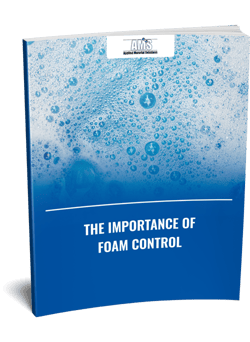The Function of Foam Control in Wastewater Treatment: Finest Methods and Techniques
The Function of Foam Control in Wastewater Treatment: Finest Methods and Techniques
Blog Article
A Comprehensive Overview to Applying Foam Control Solutions in Your Workflow
Reliable foam control is a crucial element of functional performance that often goes ignored. Understanding the details of foam generation can considerably impact both performance and item high quality. By checking out crucial elements such as application compatibility and workers training, organizations can optimize their foam management efforts.
Comprehending Foam Difficulties
Foam challenges are a considerable problem across various sectors, affecting operational performance and product quality. The development of extreme foam can hinder procedures such as mixing, transport, and storage, bring about boosted downtime and waste. In sectors like food and drink, pharmaceuticals, and petrochemicals, foam can hinder assembly line, causing item disparities and contamination threats.
Furthermore, foam can obstruct devices functionality, leading to costly repair work and maintenance. In wastewater treatment, foam can interrupt clarifier procedures, resulting in lower therapy performance and regulative conformity issues.
Comprehending the underlying reasons for foam generation is important for reliable management. Aspects such as surfactants, temperature level fluctuations, and anxiety degrees can all add to foam manufacturing. Recognizing these elements enables sectors to implement targeted techniques that lessen foam development while maintaining product stability.
Sorts Of Foam Control Solutions

Mechanical remedies include the use of tools such as foam skimmers or defoamers. Chemical services, on the other hand, consist of the application of defoaming representatives-- materials that disrupt the foam structure, leading to its collapse. Foam Control.
Last but not least, operational approaches focus on process adjustments. This may involve modifying equipment parameters, such as temperature and pressure, or changing the circulation prices of fluids to decrease foam generation. Applying great housekeeping methods can likewise mitigate foam development by lowering impurities that add to foam stability.
Selecting the ideal foam control remedy includes evaluating the particular needs of the procedure, including the type of procedure, the features of the products involved, and safety and security factors to consider.
Choosing the Right Products
Choosing the appropriate foam control items requires an extensive understanding of the particular application and its unique obstacles. Aspects such as the kind of foam, the environment in which it takes place, and the preferred outcome all play crucial duties in product option. Foam Control. In markets like food handling, it is critical to choose food-grade defoamers that abide with safety and security guidelines while properly taking care of foam.
Furthermore, take into consideration the viscosity of the liquid where the foam issue exists. Some items are developed for low-viscosity applications, while others are tailored for thicker liquids. Compatibility with existing procedures is another critical aspect; the chosen foam control representatives ought to incorporate seamlessly without interrupting total procedures.
One more important factor is the technique of application. Some items might need dilution, while others can be used straight. Evaluating the simplicity of use and the called for dose can offer insights into the item's efficiency and cost-effectiveness.
Execution Approaches
Successful application strategies for have a peek at this site foam control services require a methodical technique that lines up item choice with operational requirements. The very first step includes a detailed evaluation of the procedures where foam occurs, identifying particular areas that necessitate treatment. By involving cross-functional groups, including design, top quality, and production guarantee, companies can gather understandings that educate the choice of the most reliable foam control items.
Next, it is important to develop clear objectives for foam decrease, ensuring that these objectives are measurable and achievable. This might involve defining appropriate foam degrees and the timelines for execution. Educating personnel on the residential or commercial properties and application methods of selected foam control representatives is equally important, as appropriate use is essential for optimum results.
Additionally, integrating foam control remedies into existing operations requires mindful preparation. Ultimately, a well-structured technique will boost functional efficiency while effectively taking care of foam-related difficulties.
Monitoring and Assessing Performance
Surveillance and examining the efficiency of foam control remedies is essential for guaranteeing that applied approaches generate the desired results. This process involves systematic information collection and analysis to examine the performance of foam control representatives and techniques. Secret efficiency signs (KPIs) ought to be developed prior to implementation, permitting a clear baseline site link versus which to gauge development.

Assessing efficiency likewise needs periodic evaluations of foam control treatments and representative efficiency. This can be accomplished via sampling and testing, permitting operators to identify if present options are fulfilling functional demands. Furthermore, it is essential to get feedback from staff member that connect with these systems daily, as their understandings can expose operational nuances that quantitative information might ignore.

Ultimately, a structured monitoring and evaluation structure aids recognize essential changes, making certain that foam control remedies continue to be reliable, inexpensive, and straightened with business goals.
Conclusion
In final thought, effective foam control options are important for maximizing operational performance and keeping product top quality. An extensive understanding of foam challenges, integrated with the option of suitable items and implementation methods, facilitates the successful monitoring of foam generation.
Implementing great housekeeping techniques can likewise alleviate foam development by decreasing impurities that add to foam stability.
Selecting the appropriate foam control products needs a detailed understanding of the specific application and its special obstacles (Foam Control).Effective implementation methods for foam control remedies call for a systematic method that lines up item option with functional needs.In conclusion, efficient foam control options are crucial for maximizing operational efficiency and maintaining product high quality. An extensive understanding of foam obstacles, incorporated with the option of ideal items and execution strategies, facilitates the successful management of foam generation
Report this page